
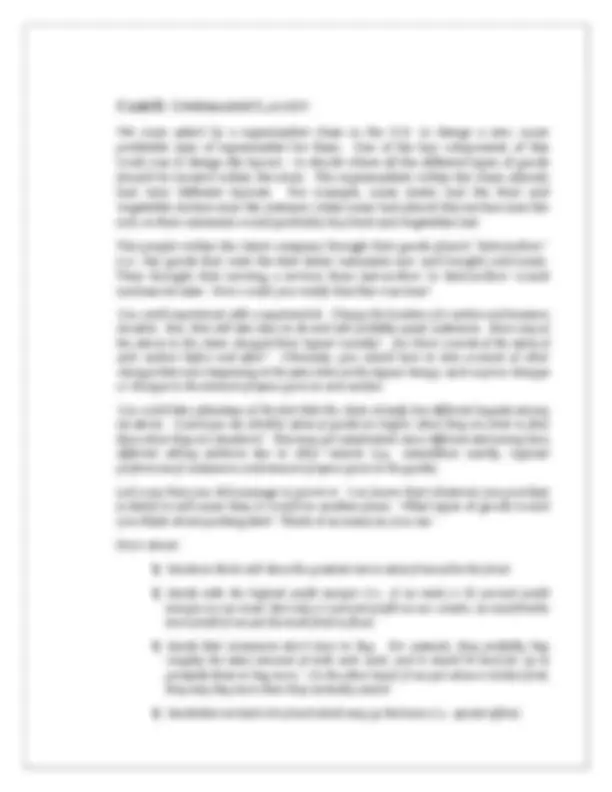
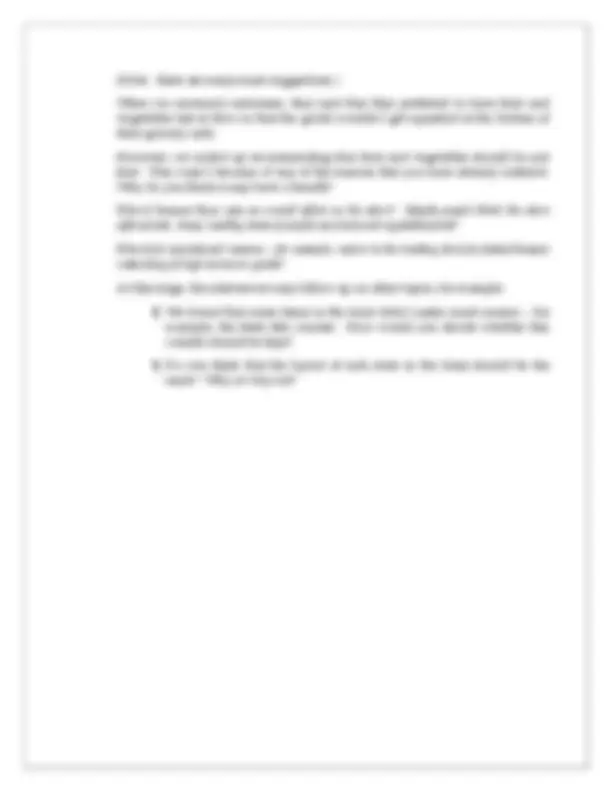
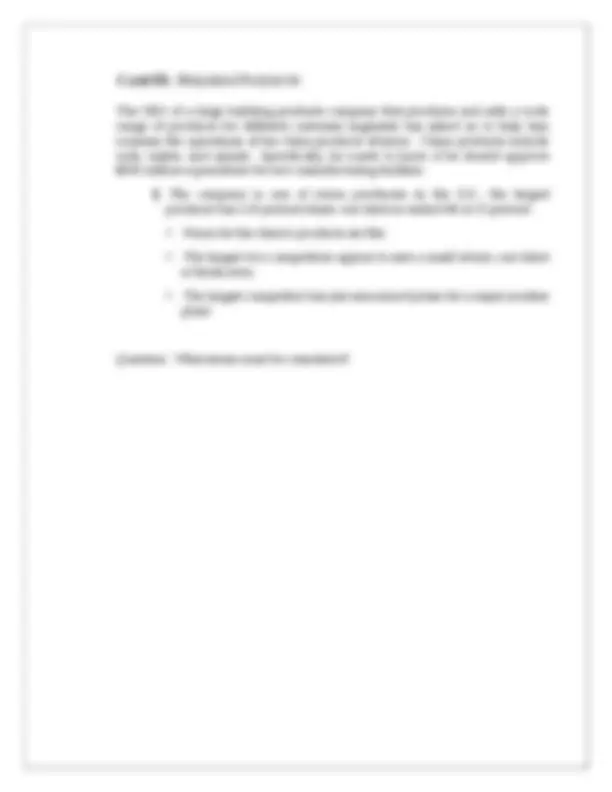
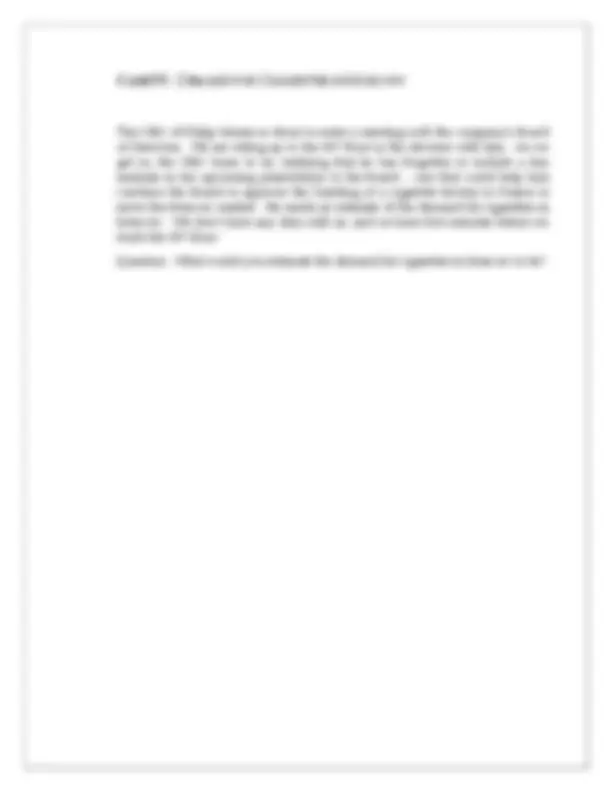
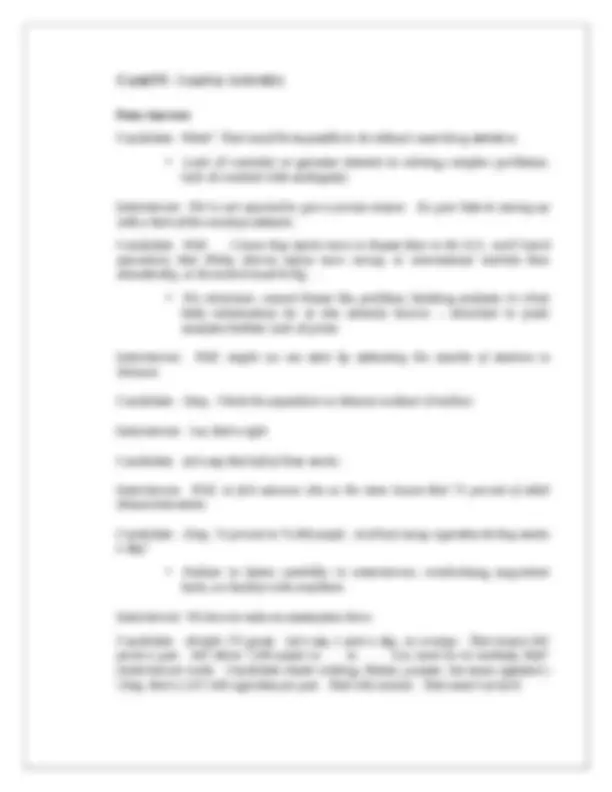
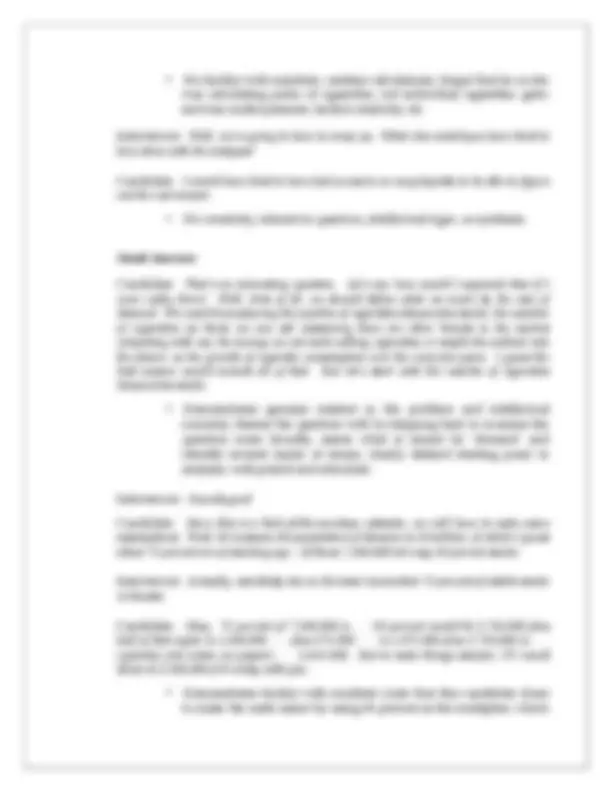


Study with the several resources on Docsity

Earn points by helping other students or get them with a premium plan


Prepare for your exams
Study with the several resources on Docsity

Earn points to download
Earn points by helping other students or get them with a premium plan
Community
Ask the community for help and clear up your study doubts
Discover the best universities in your country according to Docsity users
Free resources
Download our free guides on studying techniques, anxiety management strategies, and thesis advice from Docsity tutors
some cases from McK and helpful for consulting prep!
Typology: Exercises
1 / 12

This page cannot be seen from the preview
Don't miss anything!







Below are several examples of the kinds of cases we use in interviews. (You are not likely to come across these in real interviews, but if you do, you should tell your interviewer.) The first two cases are designed to help you walk through the issues raised in each problem and get a sense of how you should be thinking about a problem; the third and fourth cases are ones that you should work through on your own before consulting the model answers. Reasonable answers to the cases are included in italics.
Until recently, most car insurance was sold to car owners by insurance brokers. A car owner would call or visit a broker who would suggest a range of different policies sold by different insurance companies. Insurance companies would pay a commission to a broker for each policy sold.
More recently, car owners have started buying insurance directly from an insurance company over the phone. We were asked to work with a leading car insurance company that had been very successful in selling policies through brokers to help them figure out whether they should start selling their policies “direct” to customers over the phone. If you were a car owner what might be the advantages of buying insurance direct from an insurance company over the phone versus buying from an insurance broker?
For example, an insurance broker may be able to provide a service in comparing different policies from different insurance companies. However, buying direct from an insurance company over the phone may be both cheaper (since there is no commission that has to go to a broker) and may be very convenient if done efficiently over the phone.
What things would you need to consider to decide whether the insurance company should start selling car insurance over the phone?
You would have to think about:
¶ Potential Market Size: What is the existing market for direct selling? What is the market’s growth potential? How many people will prefer to buy direct over the phone instead of visiting a broker? Will the company’s existing business through brokers be in danger of declining?
¶ Competition and Profitability: How profitable could the players in the market be? What profit do the current direct sellers make versus what the companies selling through brokers make? How competitive is the market; are there many players already? Are there companies already selling direct that have a “head
start,” such as a well known brand or many policies, which allows them to have lower costs?
¶ Capabilities: How good could this particular insurance company be at this business? What would they have to be good at to do well in this business? Do they have these skills? Could they get them? At what cost?
¶ Impact on Existing Business: Will selling direct to customers adversely affect the business sold through brokers, and does this matter? Would brokers stop selling the insurance company’s policies if they knew that the company was also bypassing them and selling direct to car owners?
At this stage, an interviewer could follow up on any of the points raised in more detail. For example, he or she could ask:
¶ How would you figure out how big the market for direct selling may be in 5 years‟ time? Say at the moment that 20 percent of car owners buy their insurance over the phone directly from an insurance company. How could you figure out what percentage this could be in 5 years‟ time?
¶ What do you think an insurance company selling direct to car owners over the phone has to be good at?
(Note: there are many more suggestions.)
When we surveyed customers, they said that they preferred to have fruit and vegetables last in flow so that the goods wouldn‟t get squashed at the bottom of their grocery carts.
However, we ended up recommending that fruit and vegetables should be put first. This wasn‟t because of any of the reasons that you have already outlined. Why do you think it may have a benefit?
Was it because there was an overall effect on the store? Maybe people think the store offers fresh, cheap, healthy items if people see fruit and vegetables first?
restocking of high turnover goods?
At this stage, the interviewer may follow up on other topics, for example:
¶ We found that some items in the store didn‟t make much money – for example, the fresh fish counter. How would you decide whether this counter should be kept?
¶ Do you think that the layout of each store in the chain should be the same? Why or why not?
The CEO of a large building products company that produces and sells a wide range of products for different customer segments has asked us to help him examine the operations of his china products division. China products include tubs, toilets, and urinals. Specifically, he wants to know if he should approve $200 million expenditure for new manufacturing facilities.
¶ The company is one of seven producers in the U.S.; the largest producer has a 20 percent share; our client is ranked #3 at 15 percent.
Prices for the client‟s products are flat.
The largest two competitors appear to earn a small return; our client is break-even.
The largest competitor has just announced plans for a major modern plant.
Question: What issues must be considered?
Generally, how expensive is entry/exit? Has there been a history of change in the industry players?
¶ Manufacturing:
Do the plants produce other products/contribute to overhead?
Are there ways in which costs can be substantially lowered?
Outstanding Answers:
¶ Marketing:
Has the industry generally been charging prices that make sense given the costs of production and the needs and sensitivities of various customer segments?
Have competitors ever announced capacity expansions before and then not implemented them?
Are there opportunities to change the product line to create a better fit with customer segments and production constraints?
Does the new finish that will result from the investment “pay for itself” with higher prices?
¶ Competitive Position:
How important is the product line to each competitor?
Are the products sold in combination (with each other, or with other products such as fittings)?
Would exiting the business affect the sales, products, or costs of other business units?
Are there advantages to plants being located in specific places due to high transportation costs?
If the competitor’s new plant is built, will others drop out?
¶ External Environment:
Is regulation important?
Are there changing demographics that will affect demand?
The CEO of Philip Morris is about to enter a meeting with the company‟s Board of Directors. We are riding up to the 30th^ floor in the elevator with him. As we get in, the CEO turns to us, realizing that he has forgotten to include a key analysis in his upcoming presentation to the Board – one that could help him convince the Board to approve the building of a cigarette factory in Russia to serve the Moscow market. He needs an estimate of the demand for cigarettes in Moscow. We don‟t have any data with us, and we have five minutes before we reach the 30th^ floor.
Question: What would you estimate the demand for cigarettes in Moscow to be?
No facility with numbers; careless calculations; forgot that he or she was calculating packs of cigarettes, not individual cigarettes; grew nervous under pressure; lacked creativity, etc.
Interviewer: Well, we’re going to have to wrap up. What else would you have liked to have done with the analysis?
Candidate: I would have liked to have had access to an encyclopedia to be able to figure out the real answer.
No creativity, interest in question, intellectual rigor, or synthesis.
Good Answer:
Candidate: That’s an interesting question. Let’s see, how would I approach that if I were really there? Well, first of all, we should define what we mean by the size of demand. We could be measuring the number of cigarettes Muscovites smoke, the number of cigarettes we think we can sell (assuming there are other brands in the market competing with us), the money we can make selling cigarettes, or maybe the outlook into the future, so the growth of cigarette consumption over the next few years. I guess the best answer would include all of that. But let’s start with the number of cigarettes Muscovites smoke.
Demonstrates genuine interest in the problem and intellectual curiosity; frames the question well by stepping back to examine the question more broadly, assess what is meant by „demand‟ and identify several layers of issues; clearly defined starting point to analysis; well-poised and articulate.
Interviewer: Sounds good.
Candidate: Since this is a back-of-the-envelope estimate, we will have to make some assumptions. First, let’s assume the population of Moscow is 10 million, of which I guess about 75 percent are of smoking age. Of those 7,500,000 let’s say 50 percent smoke.
Interviewer: Actually, somebody else on the team knows that 75 percent of adults smoke in Russia.
Candidate: Okay. 75 percent of 7,500,000 is... 50 percent would be 3,750,000 plus half of that again is 1,500,000... plus 375,000... is 1,875,000 plus 3,750,000 is... (quickly jots notes on paper)... 5,625,000. But to make things simpler, I’ll round down to 5,500,000 if it’s okay with you.
Demonstrates facility with numbers (note that this candidate chose to make the math easier by using 50 percent as the multiplier, which
is perfectly acceptable); comfortable with ambiguity; able to make reasonable assumptions.
Interviewer: Sure.
Candidate: So, now we need to know how much they smoke. Let’s say 1 pack a day on average, or about 400 packs a year, times 5,500,000 people is 2,200,000,000 packs. If we assume there are 20 cigarettes in a pack, that would be 4,400,000,000 cigarettes consumed per year.
Interviewer: Are you sure that’s right?
Candidate: 2,200,000,000 packs times 20 cigarettes in each pack is... oh, of course, 44,000,000,000 cigarettes. Sorry about that. Next, if I were the CEO, I’d like to know how much of that consumption I can expect to capture. Do we know what our share of the different world markets is?
Recovered well; showed poise under pressure; pushes the analysis to the logical next step.
Interviewer: In the U.S., we have a 50 percent share, in France, we have a 25 percent share, in China, we have a 30 percent share, and in Hungary and Poland, we have a 75 percent share.
Candidate: Well, not knowing the market dynamics that lead to these different situations around the world, I would say that the Russian market is probably pretty close to Poland and Hungary. But let’s be conservative, and say that we feel confident that we can achieve 60 percent share, which would be 22,000,000,000 plus 4,400,000,000 is 26,400,000,000 cigarettes a year or 1,320,000,000 packs per year.
Good logic; comfortable with ambiguity; facility with numbers (again, the candidate chose to break down the multiplication).
Interviewer: That’s great. We’re running out of time. Anything else you would have liked to have done with the analysis?
Candidate: I would have liked to have gotten a sense of how much demand will grow over the next few years, which would be a function of population growth, growth of smokers as a percent of the population, and the amount each smoker consumes. I also would have liked to compare our estimate of demand for cigarettes in Moscow with demand in a comparably-sized city like NY, just to make sure that it makes sense intuitively. For example, I would definitely expect the size of demand in NY to be smaller. But for now, I guess all we can tell the CEO is that he needs a factory which will produce somewhere in the range of 1.3 billion packs of cigarettes a year.
Shows genuine interest and creativity; pushes analysis to the next level; sums up analysis with concise recommendation to CEO.